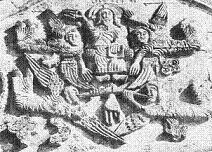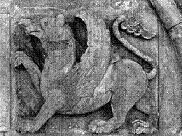LEVAN BREGADZE # 4
THE IDEOLOGY OF ANTIMIMESIS
Avant-gardists (all of them) and postmodernists (a substantial number of them) use the antimimetic means of expression, i.e. they represent realistic events in a deformed way in their works of the arts, which often causes protest of the recipients. They say, to deform the shapes of the world created by God is a Satanistic activity (Jorge of Burgos in “The Name of the Rose” by Umberto Eco is defending this point of view). That is mainly because the arts of avant-gardists and postmodernists are considered to be the arts of “unbelievers”, “ungodlies”. This point of view has been sounded many times here in Georgia too, but most sharply it was expressed in the article by Zaal Dgebuadze “Short comments on postmodermism” (Dgebuadze 2000:2). Before stating his opinion on postmodernism, the author gives a characterization of modernism:
The main feature of modernistic currents “was the deformation of the everyday realities in various ways and by various degrees (…). The name “modernism” simply refers to the whole multicolour spectrum which followed the currents of the classical arts with more or less distinctly formed ideological and esthetic principles (romanticism, realism)” (ibid.).
According to the author, the real disaster was what followed the modernism – postmodernism or the arts of “the era of jubilant unbelief”:
“An anarchistic yell – “God is dead” – which heralded that the era of jubilant unbelief was near, is the latent ideological ground of postmodernism,” – read we in the article.
Bela Tsipuria tries to fathom the essence of modernism and postmodernism with help of religion in her work “Postmodernism”. In her opinion:
“… Within the area of avant-gardism the representation becomes a self-sufficient process, it has no relation to spiritual goals, absolute truth or existential questions in traditional understanding of these concepts (…). The arts should be in no way related to super-material world (…). It has to try to achieve its expressional goals, and these goals have no relation to existential questions of the essence of life, for the essence is in expression itself” (Tsipuria 2006: 222).
And the expression, as we have mentioned in the beginning, is with avant-gardists completely and with postmodernists substantially antimimetic.
Jorge of Burgos, a character of “The Name of the Rose” by Umberto Eco, declares antimimesis as the sign of ungodliness and he is defending this position firmly in the dispute with William of Baskerville. He is especially irritated with a relief of the church portal, which represents fantastic creatures.
The fantastic figures by the painter-miniaturist Adelmus too are blasphemy for Jorge. For the Adelmus himself those non-real, non-realistic creatures, with which he decorated the manuscripts, “served to the Glory of God and were the means for understanding divine things” (Eco 2001:113. The emphasis is ours. – L. B.)
There are plenty of enigmatic and non-realistic figures on the facades of Georgian temples, especially on those of the Nikortsminda Temple (1014):
“If we cast an eye on the animal pictures of Nikortsminda, we can see, that they represent, on the one hand, the fantastic animals and, on the other hand, the animals which do not inhabit Georgia (…). In some cases the animal pictures show a new, strange combination of forms, for example: a double-headed fairytale bird (…), double-headed winged horse”, etc.(Aladashvili 1957: 76).
Not only the pictures of animals, but also the expressions of Our Saviour and the angels are antimimetic. Regarding the composition represented on the south facade (Aladashvili 1957: Tab. 10) in the above quoted work we read:
“For the expressional power of the depicted scene it is very important that the hands in the composition are expressively enlarged. The hands with wide-spread fingers of the angels are large-sized in comparison with their bodies, and the importance of the right hand gesture of Christ (blessing) is emphasized by the substantial enlargement of the hand” (Aladashvili 1957: 32.) (Pict. 1).
We can also think of the famous picture of a fairytale bird of the Samtavisi temple (1030): A fantastic creature with the lion body and the head and wings of a predatory bird (Aladashvili 1957: Tab. 41a) (Pict. 2).
As we can see, the eclecticism, for which the postmodern is blamed so much, is not a strange thing for the Christian arts as well.
In the opinion of William of Baskerville, a character of U. Eco, the deformation of real events is the means for understanding the heavenly things and in order to support his position he refers to Dionysius the Areopagit, according to whom “the naming of God is possible by the most deformed things only” (Eco 2001: 111).
There is a verse in the ancient Georgian hymnography, an iambus by the King Demetre (1125-1154), in which a portrait of the famous religious person St. Shio Mghvimeli is depicted in an antimimetic manner:
“I saw a man, hanged on the sky with a tiny hair
and the same man had halls standing on a tip of his spear,
he was sitting on a midge, chasing gazelles on a field
and was riding a horse on the sea
and shouting to heaven: God, you are blessed!”
(Translated from Georgian by Rusudan Bregadze)
What justifies the deformation of the reality in this poetic work? The peculiarities of this verse become understandable, if we recall the title of Shio Mghvimeli: Shio the Miracle-Worker (s. Sulava 2003: 42-48; Kvitaishvili 1980: 21). This iambus is, so to speak, a well-meant caricature of the saint. In this case the reality is deformed in order to represent better the essence of this great and strange toiler and the essence of his work. Generally, in such cases the deformation of the phenomenon serves to a better expression of the noumenon, since, as we know from the dialectics of noumenon and phenomenon, the noumenon cannot appear in the phenomenon completely, the understanding of the noumenon requires the abstraction from the phenomenon, and to deform the phenomenon in favour of the noumenon is one of the stages of the abstraction.
We think that the examples of the Christian arts discussed above are quite enough to make it clear that the antimimetic manner of expression cannot be self-sufficient or standing aloof from “spiritual goals, absolute truth or existential questions” (Tsipuria 2006: 222); what matters the most, is that, as the means for representation, it of itself has nothing to do with ungodliness. By means of it the people of arts try to understand the noumenon, the idea, the transcendent, the supermaterial.
And finally:
the linking of a manner of expression with the matters of belief seems to us
to be also wrong because the classification of people by a person into
groups of believers and unbelievers – irrespective of the criterion by which
it is done – is very subjective, since “the mortals are not able to understand divine
providence”
(Baratashvili 1972: 25).

(Pict. 1). |
 (Pict. 2). |
Bibliography:
Aladashvili 1959: Aladashvili N., Reliefs of Nikortsminda. Tbilisi: Publishing house of the Academy of Sciences of the Georgian SSR, 1957 (in Georgian).
Baratashvili 1972: Baratashvili N. Works. Tbilisi: Publishing house “Sabchota Sakartvelo”, 1972 (in Georgian).
Dgebuadze 2000: Dgebuadze Z. Short comments on postmodernism. Newsp. “Chveni Mtserloba”, 11-18. 08.2000, No 7, p. 2.
Eco 2001: Eco U. Der Name der Rose. Deutsch von Burkhart Kroeber. München: Deutscher Taschenbuch Verlag, 2001.
Kvitaishvili 1980: Kvitaishvili E. “Inverted world” in Akaki’s poetry. J. “Sabchota Khelovneba”, 1980, No.7 (in Georgian).
Sulava 2003: Sulava N. Georgian Hymnography of the XII-XIII Centuries. Tbilisi: Publishing house “Merani”, 2003 (in Georgian).
Tsipuria 2006: Tsipuria B., Postmodernism. In the book: The theory of literature. Tbilisi: 2006 (in Georgian).


